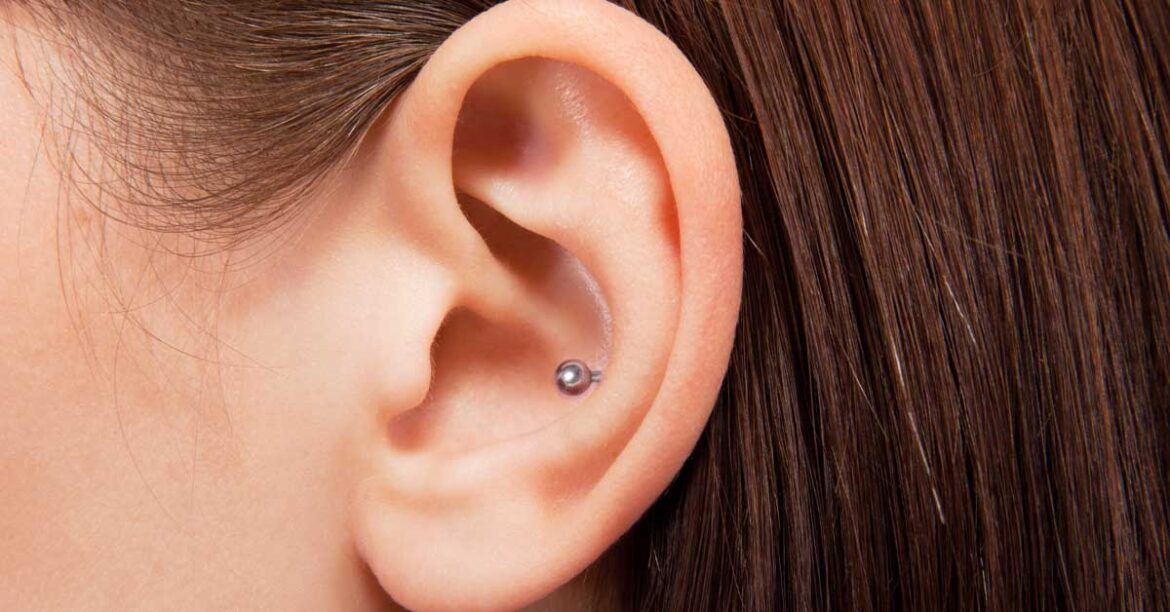What is Outer Conch Piercing?
Outer conch piercing is a type of ear piercing that is placed on the outermost part of the ear cartilage.
It is also sometimes called an auricle piercing.
This type of piercing is generally considered to be less painful than other types of ear piercings,
such as inner conch piercings or tragus piercings.
How is Outer Conch Piercing Done?
It is typically done with a hollow needle.
The piercer will clean the area to be pierced with antiseptic and mark the spot where the needle will go in.
Once the needle is inserted, a piece of jewelry (usually a captive bead ring or barbell) is placed through the hole.
Are There Any Potential Risks or Complications Associated with Outer Conch Piercing?
These can include bleeding, infection, irritation, migration of the jewelry outwards towards the skin, rejection of the
piercing by the body’s immune system, or nerve damage.
It is important to keep your piercing clean and healthy in order to prevent these issues from occurring.
What Should I Look for When Choosing an Ear Jewelry for My Outer Conch Piercing?
There are many different types of jewelry that can be used.
The type that you choose should depend on personal preference as well as factors such as your skin type and the shape of
your ear.
Some popular choices include captive bead rings (CBRs), barbells, circular barbells, studs, spikes,
dangles, or pearls.
What is the Pain Level of Outer Conch Piercing?
The pain level is generally considered to be low.
However, everyone experiences pain differently, so it is difficult to say exactly how much pain you will feel.
Some people report feeling only minimal discomfort, while others find the pain to be more intense.
How Long Does It Take for an Outer Conch Piercing to Heal?
The healing time can vary depending on the individual.
Generally speaking, it takes anywhere from 4-12 weeks for the piercing to heal completely.
During this time, it is important to clean your piercing regularly and avoid touching or playing with it unnecessarily.
Do I Need to Do Anything Special to Care for My Outer Conch Piercing During the Healing Process?
First, make sure to clean it regularly with a gentle soap and warm water.
You should also avoid touching or playing with your piercing as much as possible.
Additionally, it is important to avoid exposing your piercing to excessive heat or cold, as this can delay healing.
Finally, make sure to eat healthy foods and take good care of yourself in general during the healing process.
What Are Some Common Mistakes People Make When Getting an Outer Conch Piercing?
There are a few common mistakes that people make.
First, they may choose jewelry that is too small or too big for their ear.
This can cause irritation or even damage to the ear.
Second, they may not clean their piercing properly, which can lead to infection.
Finally, they may touch or play with their piercing too much, which can also cause irritation and delay healing.
How Much Does Outer Conch Piercing Cost?
The cost generally depends on a few factors, including the piercer’s experience level and where
you live.
In general, they are less expensive than some other types of ear piercings due to their relative ease.
You can typically get it for anywhere between $30-$60.
What is the Difference between Outer Conch to Auricle Piercing?
Outer conch piercings, also known as helix piercings, are one of the different types of ear piercings.
These piercings go through either the upper or lower cartilage on your outer ear.
On the other hand, auricle piercings are more closely associated with septum piercings and can be placed anywhere along
the rim of the ear.
Thus, there is a difference between auricle piercing and outer conch piercing in terms of location and purpose.
To Sum Up…
Getting an outer conch piercing can be a fun and exciting way to express yourself, but it is also important to take good care
of your new piercing in order for it to heal properly.
By following the tips included in this article, you can help keep your outer conch piercing clean and healthy so that you can
enjoy it for years to come.

